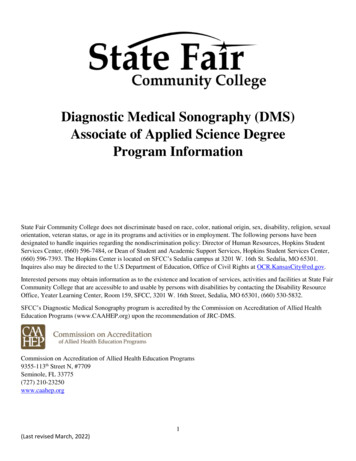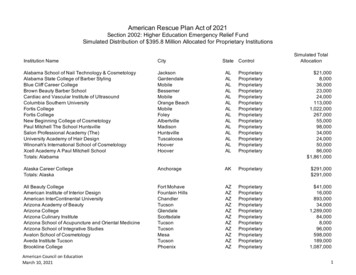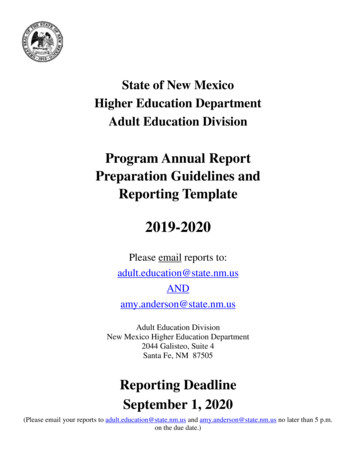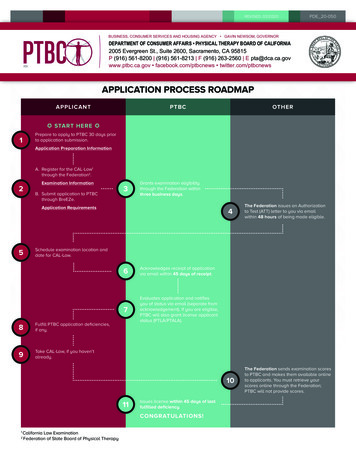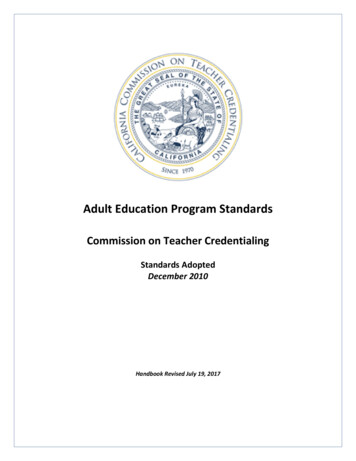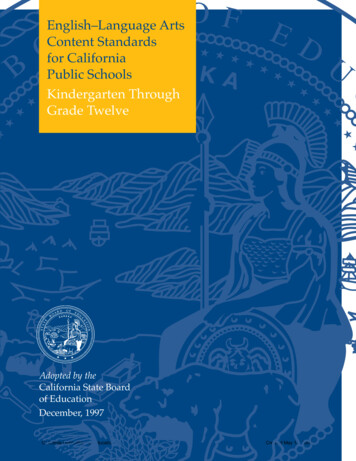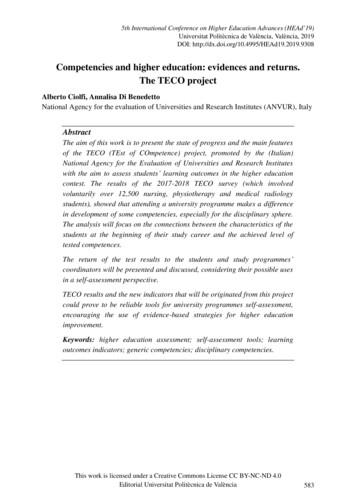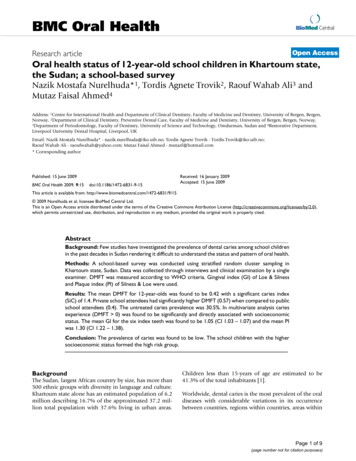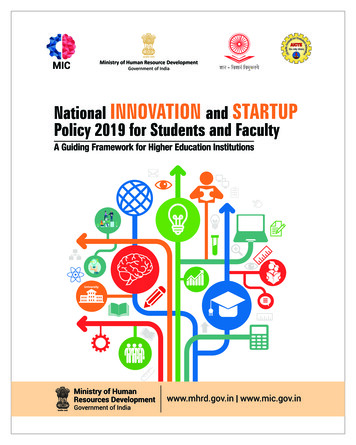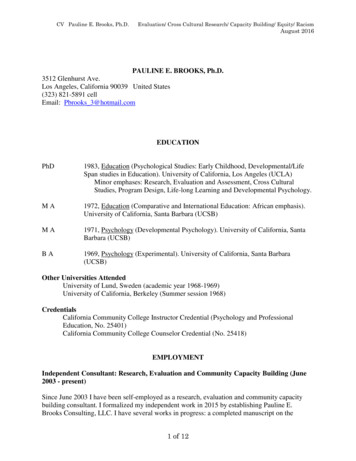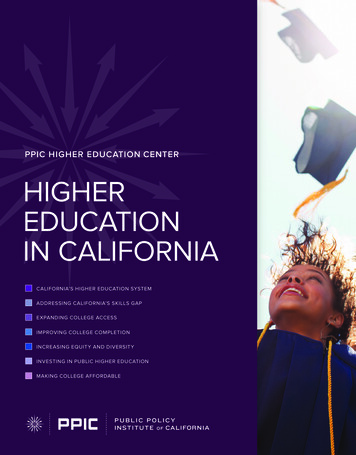
Transcription
PPIC HIGHER EDUCATION CENTERHIGHEREDUCATIONIN CALIFORNIACALIFORNIA’S HIGHER EDUCATION SYSTEMADDRESSING CALIFORNIA’S SKILLS GAPEXPANDING COLLEGE ACCESSIMPROVING COLLEGE COMPLETIONINCREASING EQUITY AND DIVERSITYINVESTING IN PUBLIC HIGHER EDUCATIONMAKING COLLEGE AFFORDABLE
California’s HigherEducation SystemPPIC HIGHER EDUCATION CENTERAPRIL 2016California’s system is the largest—and one of the most diverse—in the nationCalifornia’s higher education system includes three public segments—the University of California (UC), the CaliforniaState University (CSU), and the California Community Colleges. It also includes more than 150 private nonprofit collegesand about 200 for-profit institutions. In total, the state’s colleges and universities enroll more than two million studentsfrom a wide range of backgrounds.Most students attend public colleges, but a sizable share (26%) attend private schools. Indeed, private nonprofit collegesenroll more students than the University of California. Enrollment in private for-profit colleges has started to declineafter increasing sharply for many years.Unlike most other states, California has no coordinating body for its higher education systems. This makes goal-setting,oversight, and coordination among systems more challenging. The Master Plan for Higher Education, adopted by thestate legislature in 1960, established a structure and a set of principles for public higher education that are still largely ineffect. Through the Master Plan, the state’s public system was able to accommodate dramatic increases in enrollment forseveral decades while providing broad access and charging little or no tuition. But over the past two decades, tuition hasrisen sharply and enrollment has not kept up with demand—largely because of reductions in state support.MOST CALIFORNIA STUDENTS ATTEND PUBLIC INSTITUTIONSPrivate for-profit11%CaliforniaCommunity Colleges44%Private nonprofit15%Universityof California12%CaliforniaState University18%SOURCE: Integrated Postsecondary Education Data System (IPEDS), 2012–13 data.NOTES: Restricted to two-year or above colleges. Enrollment is for full-time equivalent students.
California’s public systems have distinct missions The University of California is the state’s primary academic research institution . . .The University of California has ten major campuses, five medical centers, and three national laboratories. Theuniversity brings in around 1 billion in federal research funds each year. Six of the schools—Berkeley, Davis,Irvine, Los Angeles, San Diego, and Santa Barbara—are members of the Association of American Universities(AAU), along with 56 other top research-intensive universities in North America. The UC system is constitutionallyindependent of the state, which means it has more autonomy than CSU; it is governed by a 26-member board ofregents. . . . yet it also educates hundreds of thousands of students.UC educates almost 250,000 undergraduate and graduate students and is the state’s primary awarder of doctoraland professional degrees. Undergraduate tuition and fees averaged 12,240 in the 2015–16 academic year, andeach campus also charges an average of 1,211 in mandatory fees. The UC is highly selective: only the top eighthof high school graduates are eligible for admission. The California State University is the largest university system in the nation.CSU provides undergraduate and graduate instruction to approximately 360,000 students on its 23 campuses. Thevast majority of students are undergraduates, but CSU awards master’s and doctoral degrees in a few professionalfields—and it trains a majority of the state’s K–12 teachers. CSU awards more bachelor’s degrees than any othersegment of higher education in California. Tuition and fees averaged 5,472 in the 2014–15 fiscal year, and localcampus fees averaged about 1,000. The top third of high school graduates are eligible for admission to CSU. TheCSU system is governed by a 25-member board of trustees; most are appointed by the governor and confirmed bythe senate. The California Community Colleges constitute the nation’s largest higher education system.The state’s community colleges enroll 2.1 million students (about 900,000 on a full-time equivalent basis) at 113colleges that are organized into 72 districts. In 2013–14, the community colleges awarded more than 60,000 certificates; 107,000 associate degrees; and transferred more than 105,000 students to four-year institutions. Comparedto other states, California relies more heavily on community colleges and less on four-year institutions—the stateranks fifth nationwide in the share of recent high school graduates who enroll in community colleges and 47th inthe share who start at four-year schools. The community colleges have multiple missions and a distinct governing structure.California’s community colleges offer lower-division academic courses for students interested in transferring tofour-year colleges; career technical education and vocational certificates; adult basic education, including Englishlanguage courses for non-native speakers; and enrichment courses for members of the community. Averageannual tuition for full-time students is about 1,100, but many students qualify for full fee waivers. The systemis governed by a 17-member board of governors appointed by the governor of California. A locally elected boardof trustees appoints campus presidents and oversees the operation and budgets of the colleges in each district.California’s private institutions vary widely in size, selectivity, and mission Private nonprofit colleges range from large research institutions to small liberal arts colleges.California’s largest private nonprofit, the University of Southern California, enrolls more than 15,000 undergraduates. In contrast, at several private nonprofits there are fewer than 500 undergraduates. Graduate studentsmake up a relatively high share of enrollment at private nonprofits. Three private nonprofits—Stanford, theUniversity of Southern California, and the California Institute of Technology—are AAU members. Privatenonprofit colleges are independent and most are governed by a board of trustees. Many belong to the Associationof Independent California Colleges and Universities. Private for-profit colleges serve large numbers of students . . .For-profit colleges award more than 60 percent of certificates in California. After years of rapid growth, enrollmentat private for-profit colleges is beginning to decline. The largest for-profit educational institutions currentlyoperating in California are the University of Phoenix, the Art Institute of California, Academy of Art University,and the Marinello Schools of Beauty; each enrolls more than 10,000 full-time students.PPIC.ORG/HIGHER-EDUCATION
. . . but there are growing concerns about cost and quality.Private for-profit colleges account for a disproportionate share of student debt and loan defaults. Controversies overthe cost and quality of the training offered by private for-profits have led to greater oversight. In 2015, one of thelargest private for-profit colleges (Heald College and its parent, Corinthian Colleges) ceased operations after investigations by the federal government and by attorneys general in several states, including California.Higher education in California is regulated by many agencies and organizationsBecause California does not have a higher education coordinating body, its colleges and universities are governed by amix of government and independent entities. As a result, the state has trouble setting goals and coordinating its manysystems. The California Student Aid Commission oversees state financial aid expenditures.The California Student Aid Commission administers financial aid programs for California residents attendingpublic and private universities, colleges, and vocational schools in the state. The Cal Grant program, one of thelargest in the country, awards 2 billion annually to students who meet academic and need-based criteria. Most ofthe awards cover tuition for low-income students at UC and CSU. There are 15 commissioners, most of whom servefour-year terms—11 are appointed by the governor and two each are appointed by the chair of the Senate RulesCommittee and the Speaker of the Assembly. The United States Department of Education provides financial aid and collects data on student outcomes.The US Department of Education administers federal financial aid programs, including grants and subsidizedstudent loans. Like many other states, California uses the department’s Free Application for Federal Student Aid(FAFSA) to determine eligibility for its own grant and loan programs. The department collects and publishes dataon thousands of higher education institutions across the country, including student outcomes such as graduationrates and student debt. This data helps the department evaluate higher education institutions. It also helps parentsand students make college choices. Accreditation agencies provide independent oversight of higher education institutions.Students cannot receive federal or state financial aid to attend higher education institutions that are not accreditedby one of several independent agencies. California’s primary accreditor is the Western Association of Schools andColleges (WASC). The Accrediting Commission for Community and Junior Colleges—a division of WASC—handles accreditation for two-year colleges (that role is being challenged by the California Community CollegeChancellor’s Office). In general, these agencies use a peer review process to evaluate the quality of higher educationinstitutions. The Bureau for Private Postsecondary Education oversees the state’s private vocational institutions.California’s Bureau for Private Postsecondary Education (BPPE) is a state consumer protection agency thatprovides oversight and limited regulation of California’s private vocational postsecondary educational institutions.BPPE monitors and attempts to resolve consumer complaints, evaluates educational quality, and provides licensesto operate.Looking aheadIn the absence of a higher education coordinating agency, how can California coordinate and regulate its higher education system? Policymakers need to find a way to set overarching, long-term goals and devise strategies to achieve them.They also need to identify the most effective ways to hold institutions accountable to students and to the state.The state needs to set new goals for its higher education system. California has not updated many of its goals forhigher education since the Master Plan was adopted more than 50 years ago, and it has no overarching plan for highereducation that is consistent with 21st-century realities. Identifying new goals—including eligibility for UC and CSU,transfer from community colleges to four-year colleges, and ensuring that college is affordable for all students—isessential if we are to measure our progress toward a shared vision for the state’s future.Funding decisions should be tied to increasing the number of college graduates. The state could encourage morestudents to go to four-year colleges by providing more funding for enrollment growth at UC and CSU, and by providingPPIC.ORG/HIGHER-EDUCATION
more Cal Grant support for students to attend private nonprofit colleges. At the California Community Colleges, thestate should consider fiscal incentives to increase high-demand vocational programs and improve transfer pathways tofour-year colleges.Higher education institutions should work with each other and with the state’s K–12 system. To improve studentoutcomes, special attention must be paid to transition points between high school and postsecondary education, andbetween two-year and four-year institutions. The actions of the segments—and individual campuses within thosesegments—are interdependent. Policymakers and higher education authorities should look to strengthen critical mechanisms of coordination between segments, including transfer processes, as well as data collection and sharing.CONTACT A PPIC EXPERTREAD MORECALIFORNIA’S HIGHEREDUCATION SYSTEMADDRESSING CALIFORNIA’SSKILLS GAPHans Johnsonjohnson@ppic.orgEXPANDING COLLEGEACCESSIMPROVING COLLEGECOMPLETIONINCREASING EQUITYAND DIVERSITYMarisol Cuellar Mejiacuellar@ppic.orgINVESTING IN PUBLICHIGHER EDUCATIONMAKING COLLEGEAFFORDABLEThis series is funded by The Sutton Family Fund.The PPIC Higher Education Center advances practical solutions that enhance educational opportunities for all of California’sstudents—improving lives and expanding economic growth across the state.The Public Policy Institute of California is dedicated to informing and improving public policy in California through independent,objective, nonpartisan research. We are a public charity. We do not take or support positions on any ballot measure or on any local,state, or federal legislation, nor do we endorse, support, or oppose any political parties or candidates for public office. Researchpublications reflect the views of the authors and do not necessarily reflect the views of the staff, officers, or Board of Directors ofthe Public Policy Institute of California.Public Policy Institute of California500 Washington Street, Suite 600San Francisco, CA 94111T 415.291.4400 F 415.291.4401PPIC.ORG/HIGHER-EDUCATIONPPIC Sacramento CenterSenator Office Building1121 L Street, Suite 801Sacramento, CA 95814T 916.440.1120 F 916.440.1121
Addressing California’sSkills GapPPIC HIGHER EDUCATION CENTERAPRIL 2016California faces a long-term shortage of college-educated workersA skilled workforce is key to a thriving California economy. Unfortunately, California’s higher education system is notkeeping up with the economy’s changing needs. If current trends in the demand for skilled workers and the educationalattainment of the state’s population continue, California will face a large skills gap by 2030—it will be 1.1 millionworkers with bachelor’s degrees short of economic demand.Falling behind in creating a skilled workforce could curtail economic growth, limit economic mobility, and increaseinequality. The economy will be less productive, incomes and tax revenue will be lower, and more Californians willdepend on the social safety net. Over time, if California’s workforce does not have the skills and training that employersneed, firms may close, relocate, or operate at lower levels of productivity.To close the gap, the state and its higher education institutions should set new goals that are consistent with the demandsof the 21st century. New investments will be necessary to meet those goals. Measuring progress and identifying programsand policies that improve student success should be key components of those investments. The good news is that changesmade today can set California on a better trajectory. But educational progress takes time, so it is important to act now.DEMAND FOR COLLEGE WORKERS WILL OUTSTRIP SUPPLY BY 20304538.440SupplyDemandShare of all workers (%)3533.0302520151050Less thanhigh school diplomaHigh schoolgraduateSomecollegeAssociatedegreeSOURCE: Johnson, Cuellar Mejia, and Bohn, Will California Run Out of College Graduates? (PPIC 2015).Bachelor's degreeor more
California’s economy needs and rewards degree holdersCurrently, one-third of jobs in California require at least a bachelor’s degree. Another third require some training beyondhigh school. Future job trends are expected to accelerate this demand. College graduates make up a large, and growing, share of the workforce.The share of workers with college degrees has increased from 24.5 percent in 1990, to 29.7 percent in 2000, andto 33.7 percent in 2013. If current trends continue, by 2030 an estimated 38.4 percent of jobs—across the entirespectrum of occupations—will require a college degree or more. The demand for skilled workers is increasing in the vast majority of occupations.Increased demand comes mostly from a growing need for highly educated workers within occupations, as opposedto a shift in the economy toward specific occupations that require higher levels of education. The share of collegeeducated workers is increasing not only in occupations that have traditionally required higher levels of education,such as computer science and health care, but also in occupations with low shares of college graduates, such aspersonal care. Educated workers earn substantially more in California . . .Even accounting for demographic and industry differences, workers earn successively more with higher levels ofeducational attainment. In 2013, workers with a bachelor’s degree earned about 70 percent more than otherwisesimilar workers with only a high school diploma. The growth of this wage differential over time is evidence of agrowing demand for higher levels of education, rather than a trend toward an over-educated workforce. . . . but fields of study and work matter.Wages for college graduates with bachelor’s degrees vary tremendously. For example, workers with engineeringdegrees earn a median annual wage of 96,000, while the median wage for workers with degrees in educationadministration and teaching is 57,000. But even this lower amount is substantially higher than the 39,000 medianannual wages of those with only a high school diploma.HIGHER EDUCATION YIELDS HIGHER WAGES75Wage premium for college graduatesrelative to high school graduates E: Johnson, Cuellar Mejia, and Bohn, Will California Run Out of College Graduates? (PPIC, 2015), based on American Community Survey, 2005–13.NOTE: Wage premiums indicate the percentage difference between wages of a college graduate and those of a high school graduate, adjusted forindividual characteristics.PPIC.ORG/HIGHER-EDUCATION
Educational attainment is not on track to meet future workforce needsThe share of college graduates in California’s workforce needs to grow to about 38 percent by 2030 to meet economicdemand, if the economy is to operate optimally. This is significantly above and beyond the educational attainment oftoday’s workforce. But if current trends continue, only 33 percent of California’s workforce will have college degrees. Retiring baby boomers reduce the number of workers with bachelor’s degrees.Today, the best-educated age group in California consists of adults ages 60 to 64. The retirement of these and otherhighly educated baby boomers is a major factor in the slow growth of working adults with at least a bachelor’sdegree. The share of skilled workers will increase only slightly—about 1 percent—by 2030. Groups with lower educational levels are becoming a growing share of the state’s population.College completion rates have historically been low among Latinos—who now make up California’s largestgroup of young adults. College completion rates have been rising among Latinos but not fast enough to meetfuture demand. The skills gap would be wider if it were not for immigration.The share of college graduates from other countries has increased quickly since 1980. Asia has replaced LatinAmerica as the leading source of immigrants, and immigrants from Asia tend to be highly educated: about60 percent of working-age Asian adults (ages 25–64) have college degrees when they arrive in California. Wereit not for this trend, the size of the skills gap would be even larger. The state needs more California-born college graduates.While immigration trends are likely to continue, future entrants to the California labor market are increasinglylikely to be from the state. California’s best approach to closing its skills gap will be to concentrate on improvingthe educational attainment of its residents. Currently, California ranks near the bottom of all states (47th) in theshare of recent high school graduates who enroll in four-year colleges or universities.Looking aheadThe key to closing a future skills gap in California is to make deliberate choi
San Francisco, CA 94111 T 415.291.4400 F 415.291.4401 PPIC.ORG/HIGHER-EDUCATION PPIC Sacramento Center Senator Office Building 1121 L Street, Suite 801 Sacramento, CA 95814 T 916.440.1120 F 916.440.1121 The PPIC Higher Education Center advances practical solutions that
